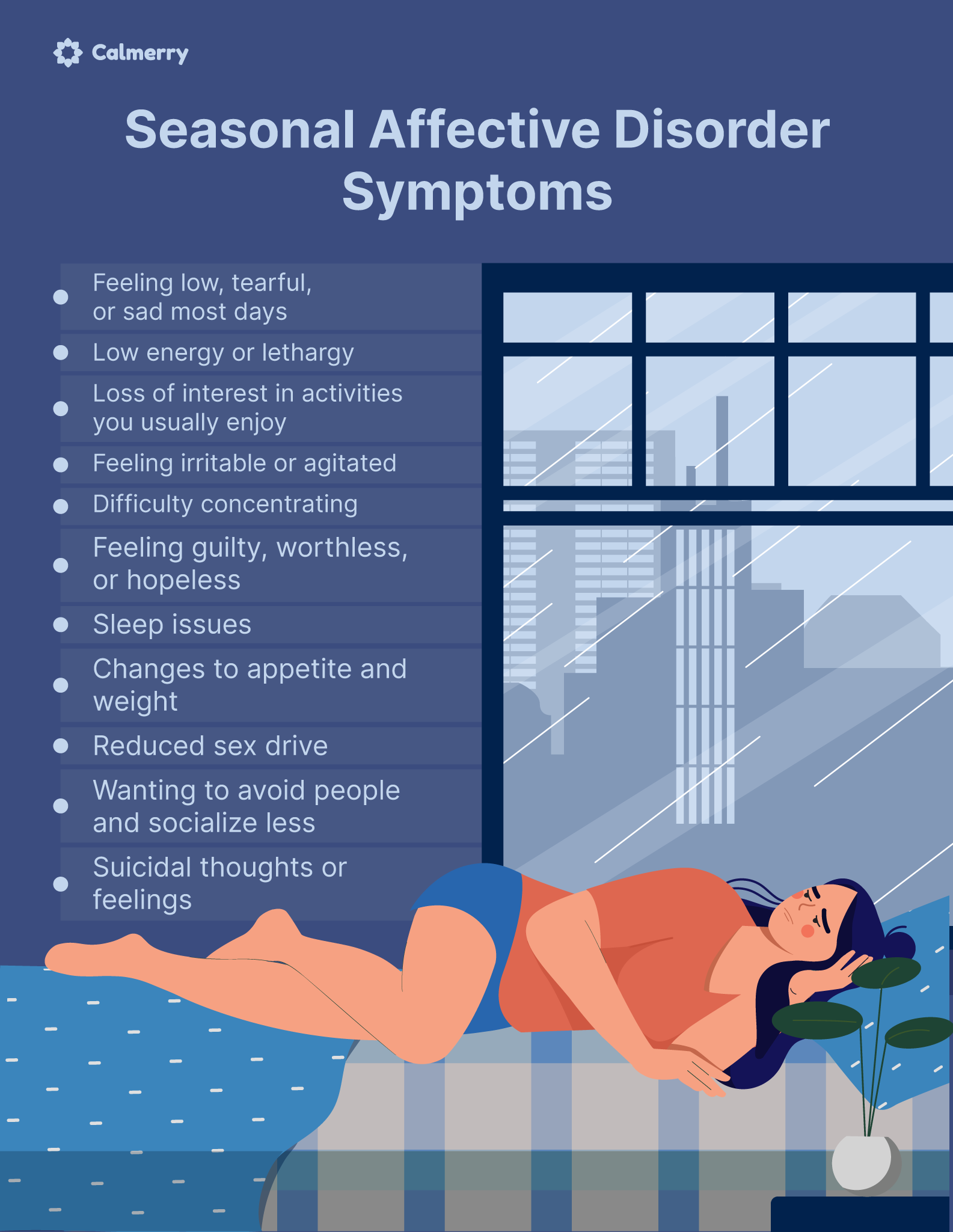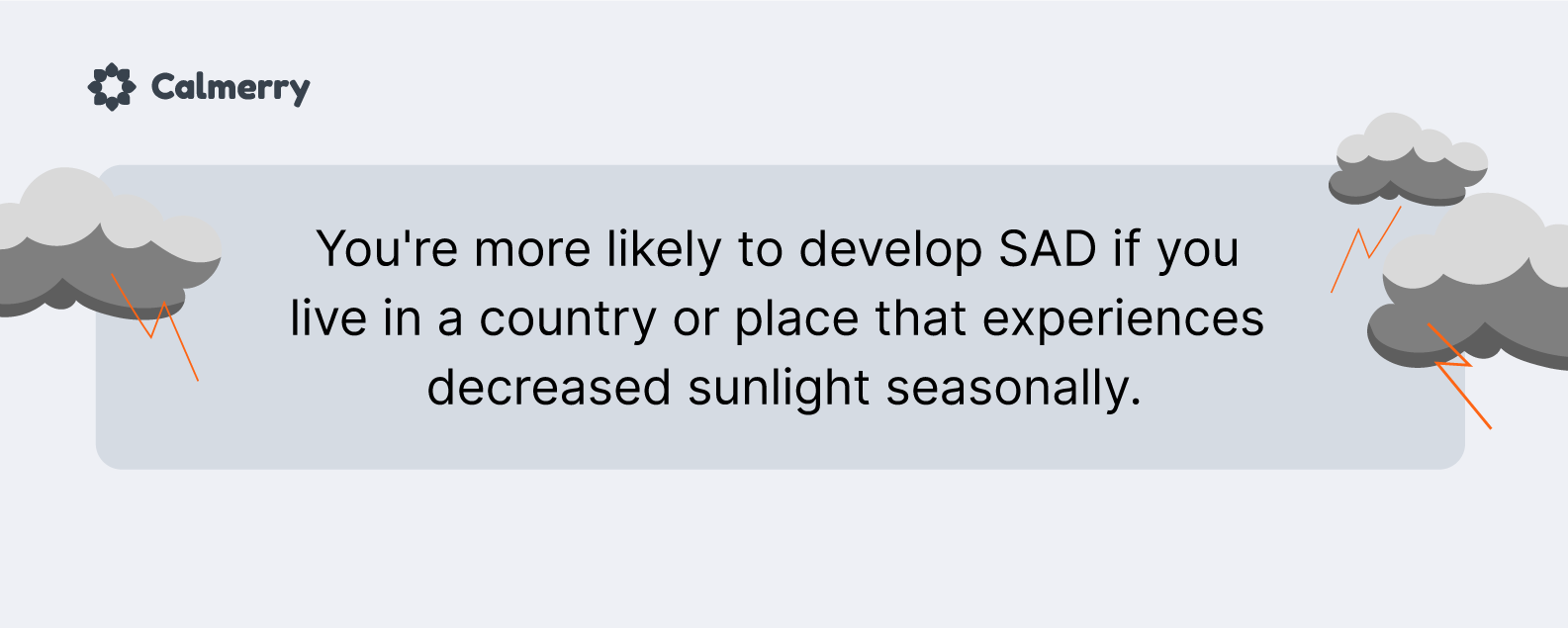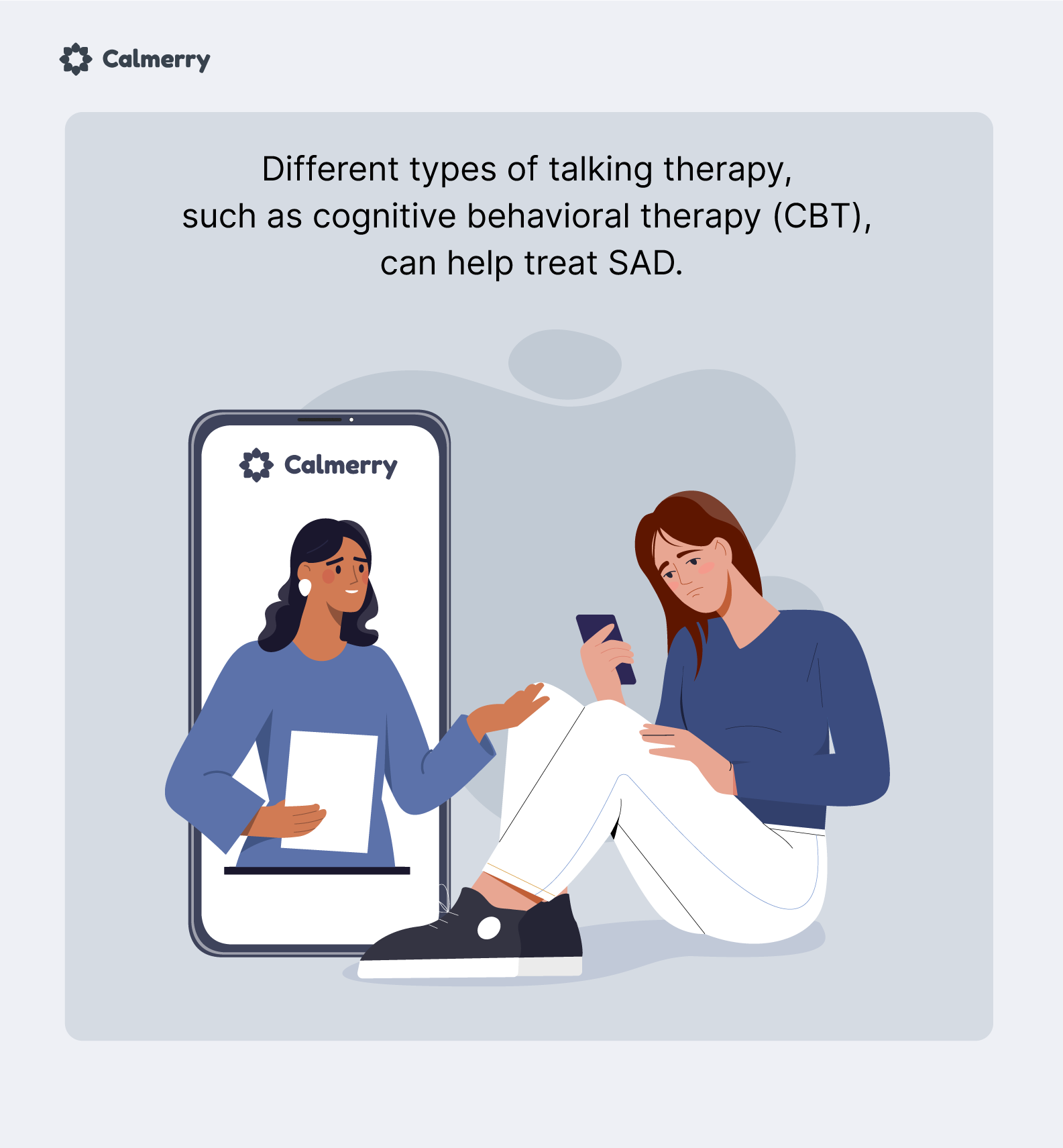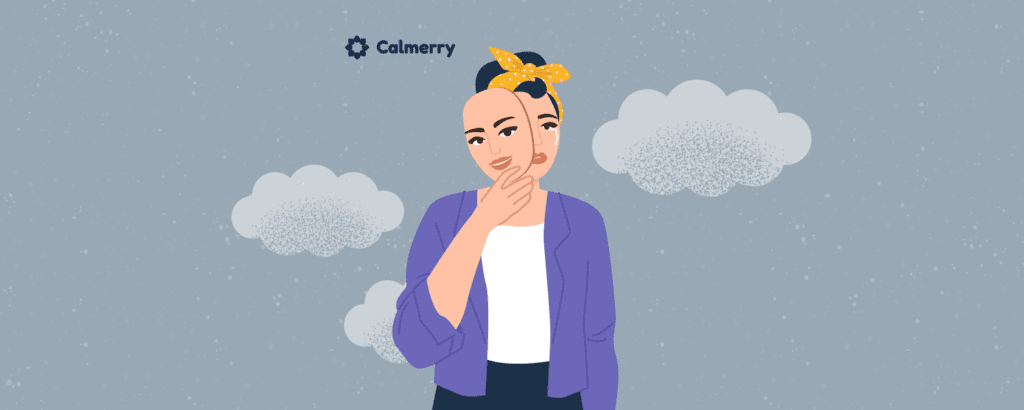Seasonal Depression (SAD): Symptoms, Causes, & Treatments

In this article
Seasonal affective disorder (SAD), also known as seasonal depression, is more than the “winter blues,” it’s a mental health condition that deserves attention. Like other types of depression, it can cause physical and mental symptoms and worsen if left untreated.
SAD can be treated, and lifestyle changes can help, too.
So, if you’re wondering, “Is seasonal depression real?” the answer is yes, and this guide will explain everything you need to know about it.
What is seasonal affective disorder (SAD)?
SAD is a type of cyclical depression that comes and goes with the seasons. [1] Seasonal affective disorder. (n.d.). National Institute of Mental Health (NIMH). https://www.nimh.nih.gov/health/seasonal-affective-disorder Most people with SAD experience it between fall and winter, but some experience it during spring and summer.
While it’s common for changes in the seasons, weather, and temperature to affect someone’s energy levels, comfort, or mood, it doesn’t necessarily mean you have SAD.
However, if the level of discomfort or distress you experience interferes with your daily life, and it always seems to occur during the same months each year, this could indicate you have SAD.
What month does seasonal depression start?
Seasonal depression typically begins in the fall and continues into the winter months. The exact timing can vary depending on your geographic location and personal sensitivity to changes in light and weather.
In general, SAD often starts in late fall or early winter and then subsides in the spring and summer. However, a less common form of SAD can occur during the spring or early summer for some individuals.
Seasonal affective disorder symptoms
The signs and symptoms of SAD are similar to those of depression, except they appear only during specific seasons. Symptoms can vary from person to person and range from mild to severe.
Here are some of the most common SAD symptoms to look out for:
- Feeling low, tearful, or sad most days
- Low energy or lethargy
- Loss of interest in activities you usually enjoy
- Feeling irritable or agitated
- Difficulty concentrating
- Feeling guilty, worthless, or hopeless
- Sleep issues
- Changes in appetite and weight
- Reduced sex drive
- Wanting to avoid people and socialize less
- Suicidal thoughts or feelings

Most people with SAD experience it during the fall and winter, but some experience it in the spring and summer. Here are some of the symptoms most commonly associated with those specific periods:
- Fall and winter: Increased appetite (especially craving carbohydrates), weight gain, sleeping more than usual, and lethargy.
- Spring and summer: Decreased appetite, weight loss, difficulty sleeping, and agitation.
Note that people with SAD might experience some, none, or all of the above or slightly different symptoms from what we’ve listed.
For some people, their symptoms are so severe that they struggle with everyday activities, whereas others are able to cope but still find their symptoms bothersome.
Causes of SAD
It’s not clear what the exact causes of SAD are. However, research suggests that reduced exposure to sunlight could play a role. Here are five ways in which a lack of the sun could contribute to SAD.
Melatonin
Seasonal changes may disrupt your melatonin levels, a hormone that your brain produces when it’s dark, to help prepare you for sleep. It has been reported that some people with SAD have higher than normal melatonin levels during the winter. [1] Seasonal affective disorder. (n.d.). National Institute of Mental Health (NIMH). https://www.nimh.nih.gov/health/seasonal-affective-disorder
Serotonin
A lack of sunlight can cause a decrease in serotonin, which may trigger feelings of depression. Serotonin is a neurotransmitter that stabilizes your mood and increases feelings of well-being.
However, it also affects your sleep, appetite, and digestion.
Biological clock (circadian rhythm)
Sunlight influences our body’s internal clock, which controls several critical functions, such as when we wake up, our state of mental alertness, physical strength, and more. The decreased light levels in the winter may disrupt your body’s internal clock and trigger SAD symptoms.
Genetic factors
There’s evidence to suggest a genetic component to SAD. [2] News-Medical.net. (2019, February 6). Genetics of seasonal affective disorder. https://www.news-medical.net/health/Genetics-of-Seasonal-Affective-Disorder.aspx Individuals with a family history of various types of depression, including SAD, may be more prone to experiencing it themselves.
Vitamin D deficiency
Sunlight is a key source of Vitamin D, which plays a significant role in serotonin activity. Reduced sunlight in the winter months can lead to a Vitamin D deficiency, which may be linked to symptoms of depression.

Risk factors
SAD affects over 7% of the US adult population. [3] Facts & Statistics | Anxiety and Depression Association of America, ADAA. (n.d.). https://adaa.org/understanding-anxiety/facts-statistics However, it’s thought that some people may be more vulnerable to it due to the following factors:
- Where you live: you’re more likely to develop SAD if you live in a country or place that experiences decreased sunlight seasonally. Such as in countries that have shorter days in the winter due to being far from the equator.
- Genes: you are more likely to develop SAD if other members of your biological family have SAD or major depression.
- Age and sex: the risk of developing SAD decreases with age; it’s more common in young people. Also, SAD is diagnosed more often in women than in men.
- Lifestyle factors and stress: people who lead a sedentary lifestyle or experience high levels of stress may be more susceptible to SAD. Engaging in regular physical activity and stress-reducing practices might help manage or mitigate the symptoms.
- Social and environmental factors: shorter days and colder weather can lead to reduced social interaction and outdoor activities, contributing to feelings of isolation and increased depressive symptoms.
- Individual response to seasonal changes: each person’s psychological and physiological response to changes in light and weather varies. Some individuals might be more sensitive to these changes, which could influence their risk of developing SAD.
- Having other mental health problems: if you have already been diagnosed with depression, bipolar disorder, or other mental health conditions, you might find that your symptoms worsen during the periods you’re affected by SAD.
When to seek help
It’s normal to have occasional days where you feel down, but if you’re finding that you regularly feel low during certain times of the year or are finding it difficult to cope, you should seek help from your doctor or a mental health specialist.
If you are having suicidal thoughts or using drugs or alcohol to cope, it’s vitally important that you seek help right away.
How to prepare for your appointment
If you’ve already booked an appointment with a doctor or mental health professional, it helps to be prepared for your meeting.
Before you go, make a list of the following and take it with you:
- What your symptoms are
- When you experience symptoms, how long they last, and what seems to trigger them
- Any other physical or mental health issues you have
- Causes of stress in your life or recent lifestyle changes
- Medications you’re currently taking
- Questions you’d like to ask
Diagnosis
A doctor or mental health specialist will usually carry out a psychological assessment to help determine whether you have SAD, which may involve questions about your:
- Symptoms and their severity
- Thoughts, feelings, and mood
- Diet and sleeping habits
- Lifestyle
- Personal and family history
They may also carry out a physical exam or lab tests to identify whether any underlying physical health problems may be contributing to or causing your symptoms.
Sometimes, it can be difficult to diagnose SAD because other forms of depression and various mental illnesses have similar symptoms.
Treatment options for seasonal affective disorder
There are various treatments available for SAD, including talking therapies, light therapy, and medication. Your doctor or health specialist will advise which treatment, or combination of SAD treatments, is the most suitable option for you, based on your diagnosis and symptoms.
Self-care and lifestyle changes can also help, which we’ll cover in the next section.

Talking therapy
Different types of talking therapy, such as cognitive behavioral therapy (CBT), can help treat SAD. CBT involves identifying negative behaviors and thought patterns that may be causing you to feel depressed and then finding ways to change them to help you feel better.
Through CBT, you can also learn healthy, effective coping strategies for SAD and how to deal with stress.
Light therapy
Light therapy typically involves sitting in front of a special light box for between 30 to 60 minutes every morning when you wake up. [4] Corliss, J. (2022, October 28). Light therapy: Not just for seasonal depression? Harvard Health. https://www.health.harvard.edu/light-therapy-not-just-for-seasonal-depression The bright light it produces mimics sunlight, helping to replace what you’re missing during the winter.
Some people find that light therapy helps considerably, but it doesn’t always work for everyone. However, when it works, most users begin seeing the benefits within a week or so. Some people find that it helps them in the short term but becomes less effective over the long term.
It’s believed that the light produced encourages the brain to increase serotonin production and decrease melatonin, therefore improving SAD symptoms in some cases.
Light therapy is also generally safe for most people and causes few side effects.
Medication
Antidepressants are often used to treat depression, and if your symptoms are severe, you might be offered them for SAD. However, there is limited evidence to support their effectiveness in treating SAD.
For SAD, antidepressants typically are most effective when taken just before and throughout the periods when you usually experience symptoms. For example, this could be from the start of fall through to the end of winter.
The most commonly prescribed antidepressants for SAD are selective serotonin reuptake inhibitors (SSRIs). They might be given alone or alongside other types of treatment. However, it can take between 4 to 6 weeks before the full benefits become noticeable, and some people may experience unwanted side effects.
Self-care tips for SAD
While seeking professional help is the best and surest way to treat SAD effectively, you can also do some things to help yourself. Keep in mind that some of the ideas below might not work for you, or you might not feel ready for them yet, which is okay.
The best advice is to try out some of them and see which ones work best for you. Don’t try to do everything at once and cause yourself too much stress; instead, take your time and remember you can always try out the other ideas later if you wish.
- Get as much sunlight as possible. Get outside often by walking, exercising, or sitting in an outdoor space or garden. Also, let light into your home and workspace by opening blinds and sit close to a window.
- Make sunlight part of your morning routine. Try to get outside in the morning within the first two hours of waking up, even if it’s cloudy. This triggers your internal body clock and makes you feel awake.
- Try a sunlight alarm clock. These alarm clocks gradually light up your bedroom in the morning, helping to prepare your body to wake up. Sunlight alarm clocks may be helpful for some people with SAD.
- Exercise. A great way to boost your mood, energy levels and relieve stress, anxiety, and depression. Aim to get at least 150 minutes of exercise per week.
- Eat healthily. Follow a balanced diet that includes many whole-natural foods like vegetables, fruits, eggs, whole grains, nuts, and avoid ultra-processed foods.
- Manage stress. Learn ways to relax and manage stress, such as through meditation, mindfulness, yoga, planning and being organized, breathing exercises, hanging out with friends, or spending time in nature.
- Socialize. When it comes to socializing, it’s quality over quantity. Avoid those who bully you or constantly put you down, but spend time with people you enjoy being around. Also, be open to meeting new people and building new connections and friendships.
- Consider traveling. If you have the time or can work remotely, you could travel to a sunnier location during the winter. Or, if you experience SAD in the summer, you could travel to a cooler place.
- Avoid drugs and alcohol. While these things may help to relieve symptoms temporarily, they leave you feeling much worse off in the long run. Alcohol and drugs can affect our brain chemistry and lead to further mental health issues, especially when used excessively.
Get effective treatment in online therapy
Seasonal affective disorder (SAD) can make certain times of the year unpleasant for some people, but thankfully, there are ways to manage and treat it.
That’s why we recommend reaching out to a health professional so you can get an accurate diagnosis and appropriate treatment if you think you might have it. When SAD is left untreated, it may worsen and lead to other mental health issues.
Our licensed online therapists at Calmerry are available and work with you if needed. They can provide professional mental health support, no matter where you are.
In addition, they have experience working with people with SAD and successfully treating it using evidence-based therapies.
Seasonal affective disorder. (n.d.). National Institute of Mental Health (NIMH). https://www.nimh.nih.gov/health/seasonal-affective-disorder
News-Medical.net. (2019, February 6). Genetics of seasonal affective disorder. https://www.news-medical.net/health/Genetics-of-Seasonal-Affective-Disorder.aspx
Facts & Statistics | Anxiety and Depression Association of America, ADAA. (n.d.). https://adaa.org/understanding-anxiety/facts-statistics
Corliss, J. (2022, October 28). Light therapy: Not just for seasonal depression? Harvard Health. https://www.health.harvard.edu/light-therapy-not-just-for-seasonal-depression
online therapy
live video session




